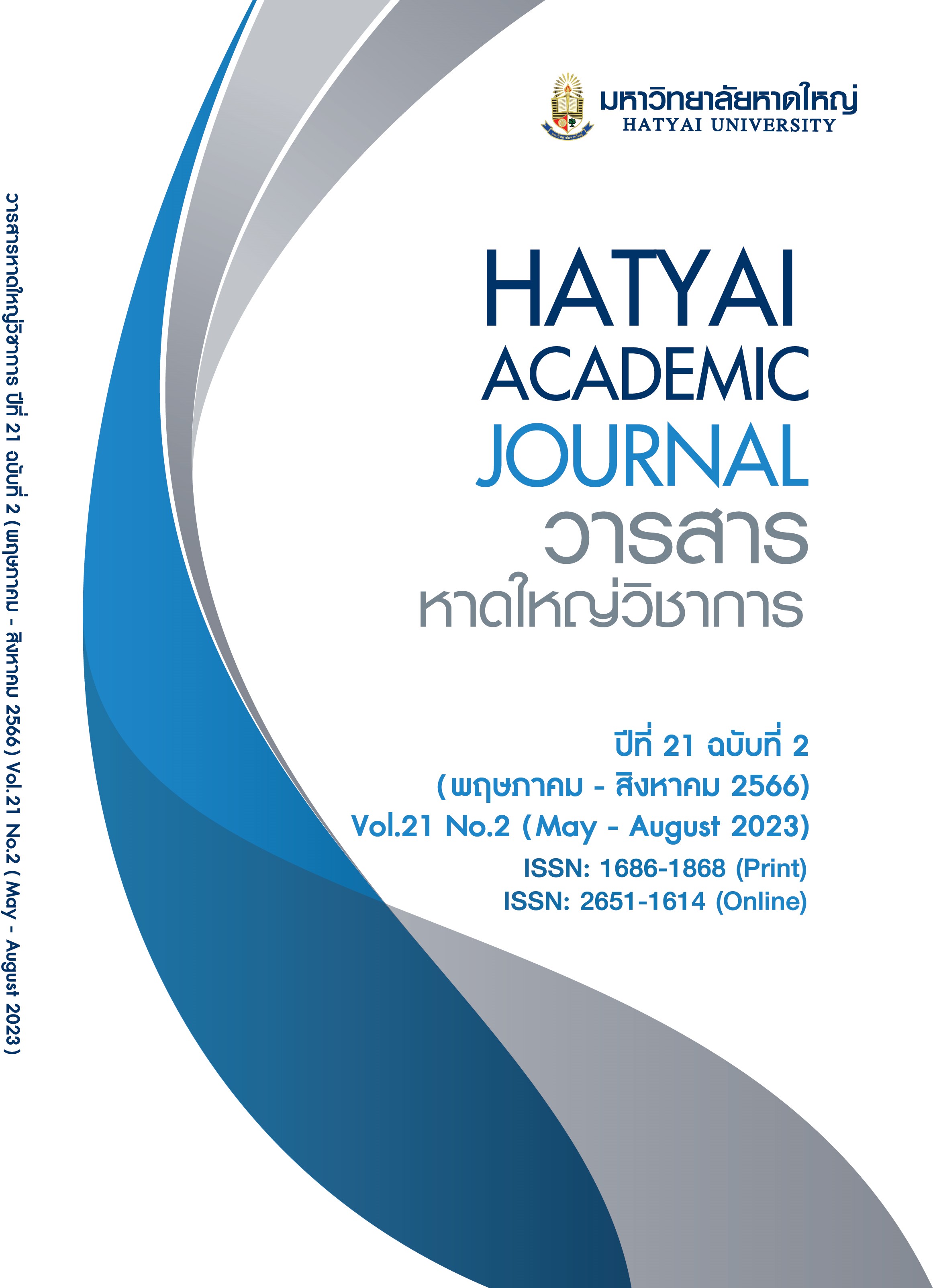อิทธิพลของรูปแบบกลยุทธ์การตลาดต่อคุณค่าตราสินค้าอาหารฮาลาลในพื้นที่ จังหวัดชายแดนภาคใต้ของประเทศไทย
Main Article Content
บทคัดย่อ
วัตถุประสงค์ของวิจัยนี้ คือ 1) เพื่อศึกษาองค์ประกอบของพฤติกรรมผู้บริโภค ส่วนประสม การตลาด การสื่อสารการตลาดแบบบูรณาการ มูลค่าเพิ่ม และคุณค่าตราสินค้าอาหารฮาลาล ในพื้นที่จังหวัดชายแดนภาคใต้ของประเทศไทย และ 2) เพื่อวิเคราะห์รูปแบบกลยุทธ์การตลาด ที่มีอิทธิพลต่อคุณค่าตราสินค้าอาหารฮาลาลในพื้นที่จังหวัดชายแดนภาคใต้ของประเทศไทย งานวิจัยนี้เป็นวิจัยเชิงปริมาณ เก็บข้อมูลโดยใช้แบบสอบถามกับกลุ่มตัวอย่างเป็นผู้บริโภค จํานวน 460 คน ที่นับถือศาสนาอิสลามซึ่งอาศัยอยู่ในพื้นที่จังหวัดชายแดนภาคใต้ของประเทศไทย ที่มีอายุ ตั้งแต่ 20 ปีขึ้นไป โดยกําหนดสัดส่วนตัวอย่างตามเพศ อายุ และจังหวัด นอกจากนั้น วิจัยนี้ใช้ การสุ่มตัวอย่างแบบชั้นภูมิกับแต่ละจังหวัด ทําการวิเคราะห์ข้อมูลด้วยสถิติเชิงพรรณนา การวิเคราะห์ องค์ประกอบเชิงยืนยัน และการวิเคราะห์โมเดลสมการโครงสร้าง ผลการวิจัยพบว่า 1) องค์ประกอบของพฤติกรรมผู้บริโภค ส่วนประสมการตลาด การสื่อสารการตลาดแบบบูรณาการ มูลค่าเพิ่ม และ คุณค่าตราสินค้าอาหารฮาลาลสอดคล้องกับข้อมูลเชิงประจักษ์ ซึ่งมีค่าดัชนีเป็นไปตามเกณฑ์ ที่กําหนด และ 2) คุณค่าตราสินค้าได้รับอิทธิพลโดยตรงจากมูลค่าเพิ่ม และได้รับอิทธิพลทางอ้อม จากพฤติกรรมผู้บริโภค ส่วนประสมการตลาด และการสื่อสารการตลาดแบบบูรณาการ โดยมี อิทธิพลส่งผ่านมูลค่าเพิ่ม อย่างมีนัยสําคัญทางสถิติที่ระดับ 0.05
Article Details

อนุญาตภายใต้เงื่อนไข Creative Commons Attribution-NonCommercial-NoDerivatives 4.0 International License.
ทุกบทความที่ได้รับการตีพิมพ์ ผ่านการประเมินจากผู้ทรงคุณวุฒิ (Peer Review) จำนวน 3 ท่าน จากหลากหลายสถาบัน โดยผู้ประเมินบทความไม่ทราบชื่อผู้เขียน และผู้เขียนไม่ทราบชื่อผู้ประเมิน (Double-blind Review)
ข้อความและบทความในวารสารหาดใหญ่วิชาการเป็นแนวคิดของผู้เขียน มิใช่ความคิดเห็นของคณะผู้จัดทำ และมิใช่ความรับผิดชอบของมหาวิทยาลัยหาดใหญ่ กองบรรณาธิการวารสารหาดใหญ่วิชาการ ไม่สงวนสิทธิ์การคัดลอกบทความเพื่อใช้ประโยชน์ทางวิชาการ แต่ให้อ้างอิงแสดงที่มาของบทความ
เอกสารอ้างอิง
Choi, C., Greenwell, T. C., & Lee, K. (2018). Effects of service quality, perceived value, and consumer satisfaction on behavioral intentions in virtual golf. Journal of Physical Education and Sport, 18(3), 1459-1468
Englund, T. R., Hedrick, V. E., Duffey, K. J., & Kraak, V. I. (2020). Evaluation of integrated marketing communication strategies used for the Fruits & Veggies Campaign in California and Virginia. Preventive Medicine Reports, 18, 101062.
Finne, A., & Gronroos, C. (2017). Communication-in-use: Customer-integrated marketing communication. European Journal of Marketing, 51(3), 445-463.
Fornell, C., & Larcker, D. F. (1981). Evaluating structural equation models with unobservable variables and measurement error. Journal of Marketing Research, 18(1), 39-50.
González-Mansilla, Ó., Berenguer-Contrí, G., & Serra-Cantallops, A. (2019). The impact of value co-creation on hotel brand equity and customer satisfaction. Tourism Management, 75, 51-65.
Grubor, A., Djokic, I., & Milovanov, O. (2017). The influence of social media communication on brand equity: The evidence for environmentally friendly products. Applied Ecology and Environmental Research, 15(3), 963-983.
Hair, J. F., Black, W. C., Babin, B. J., & Anderson, R. E. (2014). Multivariate data analysis(7th ed.). London: Pearson Education.
Huang, J., Jin, Y., Wang, X., & Zhang, J. (2019). The influence of enterprise microblogging on consumer loyalty: A social identity perspective. Nankai Business Review International, 10(2), 259-276.
Joko, J., & Hurriyati, R. (2020, February). Strengthening brand equity of local food to be a national brand class. In 3rd Global Conference on Business, Management, and Entrepreneurship (GCBME 2018) (pp. 57-61). doi: 10.2991/aebmr.k.200131.013
Kim, O. Y., Seo, S., & Nurhidayati, V. A. (2019). Scale to measure tourist value of destination restaurant service. International Journal of Contemporary Hospitality Management, 31(7), 2827-2844.
Kim, S. H., & Lee, S. A. (2020). The role of marketing communication mix on Korean customers’ coffee shop brand evaluations. Journal of Hospitality and Tourism Insights, 3(3), 291-309.
Klaysung, S., Klaysung, C., & Chueachainat, R. (2018). Comparison on brand equity of film companies in Thailand under perspective of upper secondary students in Dusit District, Bangkok. Saint John’s Journal, 21(29), 288-306. [in Thai]
Kotler, P., & Keller, K. L. (2016). Marketing management (15th ed.). Harlow: Pearson Education.
Kotler, P., Armstrong, G., & Opresnik, M. O. (2018). Principles of marketing (17th ed). Boston: Pearson Education.
Londhe, B. R. (2014). Marketing mix for next generation marketing. Procedia Economics and Finance, 11, 335-340.
Majid, M. A. A., Alias, M. A. M., Samsudin, A., & Chik, C. T. (2016). Assessing customer based brand equity ratings in family restaurant. Procedia Economics and Finance. 37, 183-189.
Mukherjee, S., & Shivani, S. (2016). Marketing mix influence on service brand equity and its dimensions. Vision, 20(1), 9-23.
Nayeem, A. R., Islam, M. S., & Akter, M. F. (2020). The influencing factors of brand equity on consumer purchase intention of cell phones in Bangladesh. GSJ, 8(1), 2247-2260.
Nikhashemi, S. R., Tarofder, A. K., Gaur, S. S., & Haque, A. (2016). The effect of customers’ perceived value of retail store on relationship between store attribute and customer brand loyalty: Some insights from Malaysia. Procedia Economics and Finance, 37, 432-438.
Pomering, A. (2017). Marketing for sustainability: Extending the conceptualisation of the marketing mix to drive value for individuals and society at large. Australasian Marketing Journal, 25(2), 157-165.
Potluri, R. M., & Potluri, L. S. (2018). Halal packaging and certification in India: Issues and challenges. International Journal of Islamic Marketing and Branding, 3(1), 35-44.
Ruangkalapawongse, S., & Ruangkalapawongse, A. (2015). Factors influencing the intention to buy a cooked and frozen Halal food products of the Muslim consumer in Bangkok Metropolitan area. Panyapiwat Journal, 7(2), 71-83. [in Thai]
Satvati, R. S., Rabie, M., & Rasoli, K. (2016). Studying the relationship between brand equity and consumer behavior. International Review, (1-2), 153-163.
Sehar, R., Ashraf, S., & Azam, F. (2019). The influence of social media’s marketing efforts on brand equity and consumer response. IUP Journal of Marketing Management, 18(2), 30-53.
Shafaei, F., & Mohamed, B. (2015). Involvement and brand equity: A conceptual model for Muslim tourists. International Journal of Culture, Tourism and Hospitality Research, 9(1), 54-67.
Solem, B. A. A. (2016). Influences of customer participation and customer brand engagement on brand loyalty. Journal of Consumer Marketing, 33(5), 332–342.
Subramaniam, K., & Khan, N. (2019). The impact of social media marketing–study from Malaysia perspective. Inti Jornal, 2019(063).
Syukur, M., & Nimsai, S. (2018). Factors influencing the purchase intention of halal packaged food in Thailand. Int. J Sup. Chain, 7(4), 1-6.
Tracy, B. (2014). Marketing (The brian tracy success library). New York: AMACOM.
Tsai, C. T. S., & Wang, Y. C. (2017). Experiential value in branding food tourism. Journal of Destination Marketing & Management, 6(1), 56-65.
Tungpradit, W., Anurit, P., & Muanchontham, R. (2017). Building brand equity through brand personality brand image influencing buying behavior of facial care cosmetic products in Thailand. Modern Management Journal, 15(1), 161-173. [in Thai]
Wahyudi, R., Thoyib, M., & Amri, D. (2021, January). Analysis of marketing mix strategy on consumer value in small and medium enterprises in Palembang, South Sumatra. In 4th Forum in Research, Science, and Technology (FIRST-T3-20). (pp. 142-146). doi: 10.2991/ahsseh.k.210122.024
Wu, Y. L., & Li, E. Y. (2018). Marketing mix, customer value, and customer loyalty in social commerce: A stimulus-organism-response perspective. Internet Research, 28(1), 74-104.
Yeo, B. L., Mohamed, R. H. N., & Muda, M. (2016). A study of Malaysian customers purchase motivation of halal cosmetics retail products: Examining theory of consumption value and customer satisfaction. Procedia Economics and Finance, 37, 176-182.

